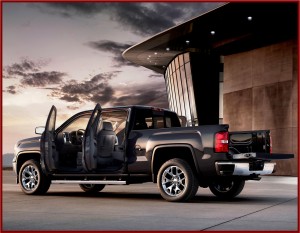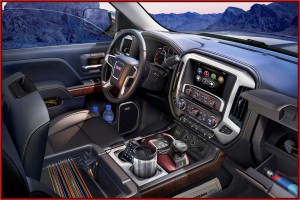General Motors has revealed revised Chevrolet Silverado and GMC Sierra pickup trucks that will enter production in the second quarter of 2013. In this highly profitable business – as much as $10,000 or more per pickup – GM has been lagging in the sales with a lineup last revised in 2007 as it was hurtling toward bankruptcy.
Now, GM is trying to reverse its slumping pickup marketshare based on fresh but conservative exterior styling with more sheet metal differences between GMC and Chevy versions. There are also three new direct injection engines that may give it fuel economy and pricing advantages against competitors.
An initial analysis by AutoInformed indicates that the trucks are good, but the question lingers – will they be good enough against Ford’s F-Series and Dodge’s Ram line, both with considerable marketplace momentum, and both with their own unique selling points from recent revisions.
Year-to-date through November, GM has sold a combined total of 506,088 Silverado and Sierra pickups. Ford Motor with its dominant F-Series, revised for the 2009 model-year, sold 576,529, which guarantees that F-Series will retain its leadership as the best selling vehicle in the United States since 1982.
Moreover, energy has been building at Ford truck as the U.S. vehicle market continues its slow recovery from an implosion in 2008. In November, the F-Series had its 16th consecutive year-over-year monthly sales increase at 56,299 pickups sold – an 18% improvement, and the best November since 2005. It was the fourth straight month with more than 50,000 F-Series sales. GM saw Silverado sales drop to 30,674 or -10.4%, and Sierra sales languish at 11,726, off -2%. The average truck on the road is now more than 10.4 years old so increase sales seem inevitable.
In addition, while GM will publicly debut the new pickups at the North American International Auto Show in Detroit this January, Ford could tease its 2015 F-Series, which has been put on a diet to increase fuel efficiency. The ongoing marketing and public relations battles are as a tough as the trucks are.
Compounding GM sales challenge in a segment it desperately needs to defend, Ram has also been posting strong sales results at a revived Chrysler Group. Chrysler’s volume leader remains the Ram pickup – more than 24,000 trucks in November, and 263,152 or +20% ytd. This truck, which is in the midst of a changeover to a technically sophisticated 2013 model with air suspension, updated engines and 8-speed automatic transmissions, had a stunning – and unsustainable – $5,000 in incentives on outgoing models during the month, kicking GM’s butt.
GM has now matched the cash on the hood in December, after vowing not to, in an attempt to stop its inventories of unsold pickups from growing higher than its 245,853 pickups at the end of November or a breathtaking 139 days supply at current selling rates. This is bad news for stockholders, including the U.S. Treasury Department that still holds 32% of GM, but good news for hard working men and women who need to replace their trucks as incentive will remain plentiful.
Leaving aside the conservative styling at GM, the truck business is based on capability that derives from chassis and powertrain. In a different approach than used at Ford or Ram, GM will offer a new engine family that includes a 4.3-liter V6 and 5.3-liter or 6.2-liter V8s. These so-called EcoTec3 engines have modern technologies – aluminum blocks and heads, 11:1 or higher compression ratios but using regular gasoline, direct injection, cylinder deactivation and continuously variable valve timing – to make the most power, torque and efficiency across a broad range of operating conditions in GM’s view.
The new V6, depending on how it is priced, will offer customers a good, potentially great, truck engine, with what GM claims will be enough torque to power a crew cab – now roughly two-thirds of the entire market and an innovation Ford debuted – and tow a trailer. The new 5.3 V8 is engineered for more horsepower, more torque and better fuel economy than the current 5.3 small block. While the 6.2 V8 is projected to be the most capable engine offered in any light-duty pickup truck, or so GM claims. As I was sitting listening to this, I thought of John Wayne responding to the bad guy’s mocking prompt “I’d call that bold talk from a one-eyed fat man.”
SAE certified horsepower and torque ratings and EPA fuel economy estimates for the Silverado and Sierra will not be available until early next year, though. Ford at the moment has multiple best-in-class claims for power, towing capacity and fuel efficiency, and has been extremely successful selling a turbocharged “EcoBoost” V6 engine rated at16 mpg city, 22 mpg highway. GM shareholders need some True Grit from the engineers here, who had better have the reins in their teeth while they hit multiple targets with both guns blazing.
“We believe these are the most technologically advanced engines ever offered in light-duty pickups, and they are 100% truck – specifically designed for the way customers use trucks in the real world,” claimed Jordan Lee, small block chief engineer and program manager. We’ll see.
All three engines will come with a six-speed automatic transmission (Dodge has 8-speeds, Ford 6-speeds) with gear ratios and shift schedules optimized for performance and efficiency. The transmissions will have Auto Grade Braking, which downshifts on downgrades to help reduce brake wear, a now common technology. Because of the added torque of the heavily revised V8 engines, new 9.5- or 9.76-inch rear axles are used.
The new trucks will prompt a real debate between GM’s naturally aspirated engines and Ford’s forced fed, turbocharger approach, which has been criticized for its overly optimistic fuel economy ratings that evaporate when you work the turbo hard. There are also potential durability and maintenance concerns. Judging by sales, though, Ford had a distinct marketing advantage here, at least for the moment.
GM powertrain is committed instead to an aggressive cylinder-deactivation approach. The new Silverado and Sierra have improved engine mounts, electronic throttle control, adaptive exhaust systems, improved aerodynamics, low-rolling resistance tires, and other technologies that help the engines operate in four-cylinder mode for longer periods of time, further increasing efficiency.
“GM pioneered cylinder deactivation, and we consider it a great technology for improving the efficiency of full-size trucks,” said Lee.
The system uses oil pressure, controlled by the powertrain control module, to deactivate the lifters on selected cylinders, closing the valves for those cylinders. It deactivates four of the cylinders on the V8 engines and two cylinders on the V6 under light load conditions – operating the engines as a V4. The system reactivates the cylinders when the driver demands greater power, in a transition that takes less than 20 milliseconds.

The new upright instrument panel, six-gauge cluster and multiple storage areas is functional and attractive.
In contrast with the mild exterior styling, the Silverado and Sierra interiors have been significantly changed. Both are immediately striking, well designed and with multiple storage areas. The instrument panels with the now requisite touch screens have large knobs and easily readable typefaces. Car interior designers at all automakers could and should learn many things from this user-friendly approach.

A lot of time was spent in the wind tunnel to turbulence, with new mirrors, triple-sealed inlaid doors, as well as roof and tailgate tweaks that all should help air flow smoothly and quietly.
In back of the cab, even the bed has been revised. “Corner Step” bumper and built-in handgrip pockets in the new bed rail protectors make it easier to step up into the bed and get to cargo on both the Chevy and GMC are nice touches. As is a tailgate with an internal torsion bar that reduces the effort to raise and lower it, while a rotary damper allows for a more gradual lowering motion when opening the tailgate.
A locking feature, two-tier loading and a box lamp are standard. A new option includes upper tie-down hooks that make it easier to secure cargo, and LED lamps under the bed rails that make it easier to see items in the bed.
There is a lot riding on these new Silverado and Sierra pickup trucks at GM. On paper, they look strong. However, it will be the execution once production starts, as well as the delivery of competitive fuel efficiency and torque and towing numbers that will determine if GM can claw back some marketshare. The head GM North America, Mark Reuss, said at the preview that he intends to become the leader in pickup sales, which for the moment is just bold talk until production starts.



